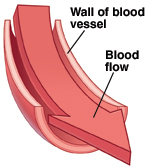Understanding Your Cholesterol Numbers
|
 |
| Blood flows easily when blood vessels are clear. |
|
|
 |
| Less blood flows when cholesterol builds up in the walls of the blood vessels. |
|
The higher your blood cholesterol, the greater your risk for heart attack or stroke. That’s why you need to know your cholesterol level. If it’s high, you can take steps to bring it down. Eating the right foods and getting enough exercise can help. Some people also need medication to control their cholesterol. Your healthcare provider can help you get started on a plan to control your cholesterol.
Checking Your Cholesterol
Your cholesterol is checked with a simple blood test. The results tell you how much cholesterol you have in your blood. Get checked as often as your healthcare provider suggests. As you work to lower your cholesterol, your numbers will change slowly. But they will change. Be patient and stay on track.
Your Total Cholesterol Number
A blood test will give you a number for the total amount of cholesterol in your blood. The higher this number, the more likely it is that cholesterol will build up in your blood vessels. For your health, it is suggested that your total cholesterol be lower than 200 . Even if your cholesterol is just slightly high, you are at increased risk for health problems.
Your Lipid Numbers
Total cholesterol is just one part of the story. Cholesterol is made up of different kinds of fats, or “lipids.” If your total cholesterol is high, knowing your lipid profile is important. The two most important lipids are HDL and LDL. Lipids are checked during a “fasting” blood test (you don’t eat for a certain amount of time before the test is done). And along with cholesterol, triglyceride (another type of fat) can also lead to blocked arteries. So, knowing your HDL, LDL, and triglyceride numbers as well as your total cholesterol gives you a more complete picture of your cholesterol level.
-
HDL is called the “good” cholesterol. It moves out of the bloodstream and does not block your blood vessels. HDL levels are affected by how much you exercise and what you eat. For most people, HDL should be 40 or higher if you’re a man and 50 or higher if you’re a woman.
-
LDL is called the “bad” cholesterol. This is because it can stick to your artery walls and block blood flow. LDL levels are most affected by what you eat. For most people, LDL should be lower than 100.
-
Triglyceride is a type of fat the body uses to store energy. Too much triglyceride can increase your risk for heart disease. Triglyceride levels should be under 150.